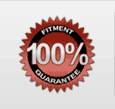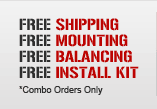Wheel Manufacturing

| WHEEL MANUFACTURING | |
WHEEL CONSTRUCTION 101 |
|
| The aftermarket wheels industry has evolved over the years; there have been several methods and materials when it comes to manufacturing wheels. Everything from aluminum alloy to steel and magnesium alloy has been used to forge wheels. Aluminum alloy wheels are broken into single-piece wheels and multi-piece wheels. Single-piece, or one-piece wheels are made in a variety of ways. Gravity casting, low-pressure casting, tilt die-casting, and forge are the ways to make a one-piece. Casting is the most common method and is a fairly basic concept. It basically involves getting molten aluminum inside of a mold to form a wheel. Below is a description of the ways to cast a wheel. | |
GRAVITY CASTING |
|
| This is the most basic method of pouring molten aluminum into a mold using the earth?s gravity to fill the mold. Gravity casting is a good way for casting designs that are more visual or when reducing weight is not a primary concern. Since using the earth?s gravity is essential, you will likely find air pockets in the aluminum which could eventually lead to stress cracks and pitting. Gravity cast wheels also will have a higher weight to achieve the required strength. | |
LOW-PRESSURE CASTING |
|
| Low-Pressure casting uses positive pressure to move the molten aluminum into the mold quicker and get a finished product that has improved mechanical properties over a gravity cast wheel. There are also high-pressure cast wheels on the market, which require special equipment to produce. The high-pressure casting will yield a lighter and stronger wheel as compared to the low-pressure cast. | |
TILT DIE-CASTING |
|
| This is a new process of casting where the mold is tilted to almost 90 degrees and then the molten aluminum is poured and the mold moves back to its original position. This process minimizes the bubbling effect of aluminum and reduces air pockets. Due to the high cost of producing such a cast, they are not widely produced. | |
FORGED or SEMI-SOLID FORGED |
|
| Forging is the method of forcing a solid billet of aluminum between the forging dies under an extreme amount of pressure, which is usually around 8000 to 10000 tons. After being put under that pressure, the aluminum is already in the shape of a wheel, even before it?s machined down to the finished product. When it becomes finished it is very dense, strong, and very light.
Semi-solid forging is the process of heating a billet of alloy to an almost liquid state and then the aluminum is forced into a mold at a high rate. The finished product offers mechanical properties that are similar to the forged wheel without the costs of production. Currently only SSR in Japan is licensed to conduct this sort of casting wheels. |
|
MULTI-PIECE WHEELS |
|
| Multi-piece wheels are usually comprised of two or three parts assembled together to produce the wheel. The rim sections for the three-piece are spun forge or roll formed from blocks of aluminum. Three-piece rim sections usually offer the ability to custom-tailor wheels for special applications that otherwise would not be available from a one or two-piece set. The rim sections are bolted to the center and normally a sealant will be applied at the assembly area to seal the wheel.
This type of construction was originally designed for race cars in the early 1970s and have been used on cars ever since. The benefit of the three-piece wheels was that in the event you damage a rim section, you could replace that section rather than the entire wheel. Multi-piece wheels can use as many various methods of manufacturing the center design, cast, and forged. Centers can be cast like a single-piece with the various details, textures, and shapes. Lately, forged have been manufactured by taking a piece of forged disk and having a CNC machine remove sections to create the wheel?s styles. This way is not the same as forging the center disk into shape, since the forged disks are cut into various designs. Three-piece wheels are most popular in the 18-inch and larger wheels with widths as large as 13 inches. |
|
TWO-PIECE WHEELS |
|
| The two-piece design does not offer as many customizations as the three-piece wheel sets do, but they are just as common in the marketplace. Some have the center bolted into a cast rim section and other manufacturers press centers into spun rim sections and weld them together. On the high-end of the two-piece wheel market, the wheels will have forged rims and centers. Since they are not sold at a high volume because of production costs, they tend to be expensive. | |
Popular Rims and Tires Links
Black Rims and Tires Chrome Rims and Tires Cheap Rims and Tires Wheels Bargains 14 Inch Rims and Tires 15 Inch Rims and Tires 16 Inch Rims and Tires 17 Inch Rims and Tires 18 Inch Rims and Tires 19 Inch Rims and Tires 20 Inch Rims and Tires 21 Inch Rims and Tires 22 Inch Rims and Tires 24 Inch Rims and Tires 26 Inch Rims and Tires 28 Inch Rims and Tires Rims and Tires Specials Wheel and Tire Packages Rims and Wheels Brands Tires Brands 15 Inch Tires 16 Inch Tires 17 Inch Tires 18 Inch Tires 19 Inch Tires 20 Inch Tires 22 Inch Tires 24 Inch Tires 26 Inch Tires Cheap Tires Tire Specials All Tires Forged Rims and Tires Custom Rims 1 Piece Wheels Information 3 Piece Wheels InformationPopular Car Rims Webpages
Acura RSX Rims Acura Integra Rims Audi A4 Rims BMW 3-Series Rims Cadillac Escalade Rims Chevy Cavalier Rims Chevy 1500 Rims Chevy Silverado Rims Crysler 300 Rims Chevy Tahoe Rims Dodge Charger Rims Dodge Magnum Rims Dodge Neon Rims Dodge Ram Rims Ford Expedition Rims Ford Explorer Rims Ford Focus Rims Ford Mustang Rims Ford F-150 Rims GMC Yukon Rims Honda Civic Rims Honda Accord Rims Hyundai Santa Fe Rims Infiniti G37 and G35 Rims Mercedes S-Class Rims Mitsubishi Eclipse Rims Mitsubishi Lancer Rims Nissan 350Z Rims Scion tC Rims Scion xB Rims Subaru Impreza Rims Toyota Camry Rims Toyota Celica Rims Toyota Corolla Rims Volkswagen Beetle Rims Volkswagen Jetta RimsCopyright 2008 - 2025 © RimsDealer.com, INC. All rights reserved. Development and SEO by HighTechWeb, INC.









